
National Flag of Scotland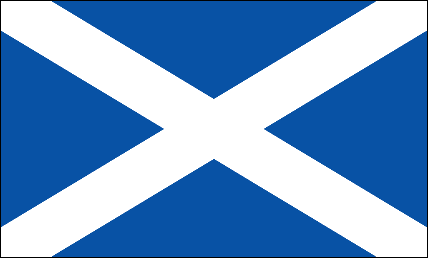
|
Full country name: Scotland Capital city: Edinburgh The National Flag of Scotland is the Cross of Saint Andrew. St. Andrew is Scotland's patron saint. His cross is now Scotland's flag. The flag consists of a dark blue base with a white St. Andrew's cross through the middle of it.Tradition states that Scotland adopted St. Andrew, a disciple of Jesus who is said to have been crucified on a cross with diagonal beams (X-shaped), as their patron saint. His remains were preserved, and Constantine wanted to remove them to Constantinople. A Greek monk was warned by an angel of this intent, and was instructed to take them to the ends of the Earth. This he did, until he was shipwrecked in Scotland. St. Andrew's bones were buried in Scotland. A second legend says that King Angus, about to lead his army into battle against a stronger force, spent the night praying for divine guidance and St. Andrew appeared in his dreams, promising victory. The next day the King saw white clouds form a saltire (cross) when he looked up into the blue sky. After this vision Angus led his soldiers to victory and he proclaimed St. Andrew as the patron saint of Scotland. The Saint Andrew cross is one of the oldest national flags of all, dating back at least to the 12th century, although the honor of the oldest flag among modern nations generally falls to the flag of Denmark. |
National Flag of Ireland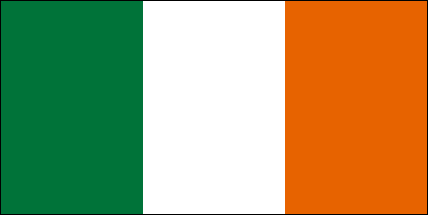
|
Full country name: The Republic of Ireland (Eire) Capital city: Dublin The National Flag of Ireland is based on the French Tricolore. It has three equal sized vertical sections. The green left stripe represents the Catholics; the orange right stripe represents the Protestants; and the center white stripe is symbolic of peace between the two.There is a cocktail called the "Irish flag" which consists of 2 cc Mint spirit, 2 cc Irish cream, and 2 cc Grand Marnier. The ingredients have to be poured in the above order and very gently down a long spoon so that the colored liquids do not mix together. The drink, when made, resembles the green, white, and orange of the Irish flag. |
National Flag of Slovakia
|
Full country name: Slovak Republic Capital city: Bratislava The National Flag of Slovakia consists of three equal horizontal bands. The top band is white, the middle band is blue, and the bottom band is red. Blue, white, and red are traditional Slavic colors which stand for Slavic unity and independence. To the left side of the flag is Slovakia's coat of arms, representing Slovakia's past link with Hungary. The coat of arms is outlined in white and features a white patriarchal double cross on a red base with a blue triple mountain. The cross represents Orthodox Christianity and the mountains symbolize the mountain regions across the country. |
National Flag of Czech Republic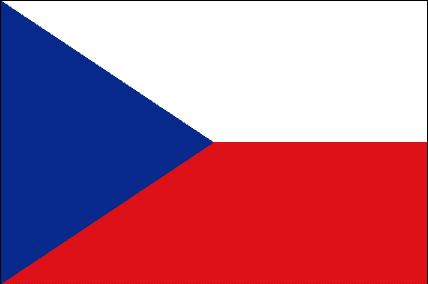
|
Full country name: Czech Republic Capital city: Prague The National Flag of The Czech Republic consists of two horizontal halves. The top half is white and the bottom half is red. On the left side of the flag is a horizontal blue triangle. The flag doesn't have any significant meaning. The colors and pattern were selected mainly to produce a flag that would be easily recognizable, especially in battle. |
National Flag of France
|
Full country name: French Republic Capital city: Paris The National Flag of France has three equal vertical bands of a blue left stripe, white middle stripe, and red right stripe. Known as the "Le drapeau tricolore" (French Tricolor), the origin of the flag dates to the French Revolution. The French flag is one of the world's oldest flags.The colors of the French flag "combine" different symbols, invented after the fact: - Blue is the color of Saint Martin, a rich officer who ripped his blue cloak with his sword to give one half of it to a poor man begging in the snow. This is the symbol that the rich have to help the poor. - White is the color of the Virgin Mary, to whom the Kingdom of France was consecrated by Louis XIII; it is also the color of Joan of Arc, under whose banner the English were finally driven out of the Kingdom. It became the color of Royalty. - Red is the color of Saint Denis, the saint patron of Paris. The original war banner of the Kings was the red banner of Saint Denis. |
National Flag of Germany
|
Full country name: Federal Republic of Germany Capital city: Berlin The National Flag of Germany has three equal horizontal bands; the top band is black, the center band is red, and the bottom band is gold. The colors are from the uniforms of German soldiers that fought during the Napoleonic wars - black coats with red braid and gold buttons. |
National Flag of Hungary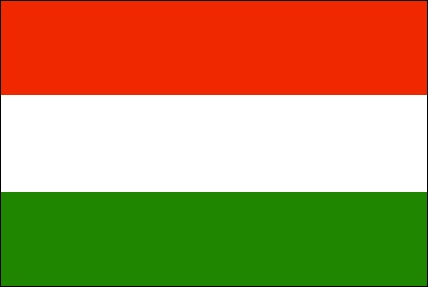
|
Full country name: Republic of Hungary Capital city: Budapest The flag of Hungary consists of three equal sized horizontal stripes - the top stripe is red symbolizing strength; the middle stripe is white representing faithfulness; and the bottom stripe is green for hope.The Hungarian flag's design was based on the French Tricolore, used during the French Revolution. The Hungarian royal crown appeared in the center of the national flag until 1945. The current Hungarian flag was first used in the 1848-1849 uprising. However, after the revolution failed, many different flags were used representing Hungary while under control of other nations. In 1956, Anti-Soviet feelings led to the readoption of the plain red-white-green horizontal striped Hungarian flag. |
National Flag of Canada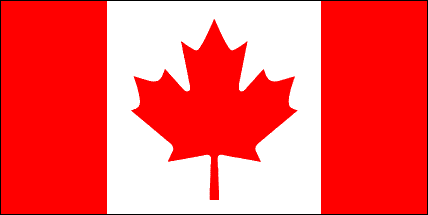
|
Full country name: Canada Capital city: Ottawa The Canadian flag consists of three vertical stripes. The right and left stripes are red and of equal size. The center stripe is white and in the middle of it is a red 11-pointed maple leaf emblem. The center stripe covers half of the width of the flag; while the red stripes cover one quarter each.The flag's official colors were proclaimed by King George in 1921. The color red was taken from the Saint George's Cross and the color white from the French royal emblem. The Canadian flag is also known as the Maple Leaf flag and was inspired by the flag of The Royal Military College of Canada. During World War I, Prime Minister Lester Pearson noticed that most Canadian battalions included a maple leaf in their insignia. Therefore, Pearson vowed he would campaign to put the maple leaf on the Canadian flag. Fifty years later, Pearson was involved in a 33-day debate which resulted in the maple leaf being placed on the Canadian flag. |
National Flag of Croatia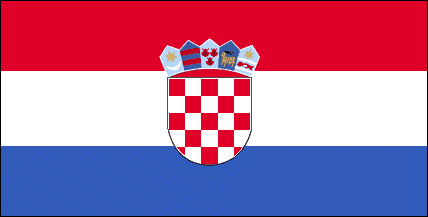
|
Full country name: The Republic of Croatia Capital city: Zagreb The Croatian flag consists of three horizontal stripes - the top stripe is red; the middle stripe is white; the bottom stripe is blue. In the center is the Croatian coat of arms.The red, white and blue are traditional Croatian colors. The centered coat of arms was first used during World War II. The main area of the coat of arms is a checkerboard that consists of 13 red and 12 silver (white) fields. The checkerboard has been a symbol of Croatian kings since at least the 10th Century. The shields above the checkerboard represent the historical regions from which Croatia originated, Croatia, Dubrovnik, Dalmatia, Istria, and Slavonia (left to right). An unofficial interpretation of the flag states that the colors represent the three symbols of Croatian history and people - the red represents the blood of Croatian martyrs; the white symbolizes Croatia's peaceful lamb like nature; and the blue represents Croatian devotion to God. The Croatian flag was adopted on December 21, 1990, making it one of the world's newer flags. When Croatia was part of Yugoslavia, its flag was the same, except for a five-pointed red star with a yellow border in place of the coat of arms. |
National Flag of Latvia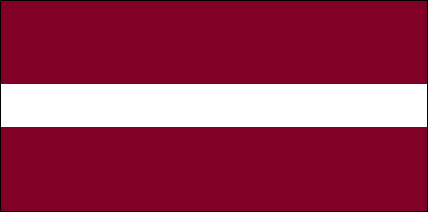
|
Full country name: Republic of Latvia Capital city: Riga The flag of Latvia consists of a maroon base with a white horizontal stripe running through the center of it. The modern flag is symbolic of a revered time-honored legend. It is told that the deep red color is representative of the blood shed by a wounded Latvian leader, and the white represents the cloth used to wrap his wounds.The meaning of the Latvian flag was described as: "White stands for right and truth, the honor of free citizens and trustworthiness. But the maroon/red reminds us of the blood that has been shed in the recent past. It has been shed at all times in the remote past and we are ready to offer it again for freedom and independence, for our nation and country." The Latvian flag is reported to date back to a military unit in 1279, which would make it one of the oldest national flags in the world. |
National Flag of Netherlands
|
Full country name: Kingdom of the Netherlands Capital city: Amsterdam The flag of the Netherlands consists of three equal sized horizontal stripes - the top stripe is red; the middle stripe is white; and the bottom stripe is blue.The flag was originally orange, white and blue and featured up to nine stripes. The Netherlands flag is nicknamed the 'Prince's Flag' and was based on the heraldic colors (coat of arms) of Prince William of Orange, who led the campaign for independence against Spanish rule. The orange stripe was changed to red but the reason is unclear. One theory is because red is more visible than orange when viewed from a distance. Another theory is because the orange dye used on the flag was unstable, and turned red after exposure to the sun. |
National Flag of Poland
|
Full country name: Poland Capital city: Warsaw The flag of Poland consists of two horizontal stripes of equal width - the top half is white and the bottom half is red. The colors of the flag are defined in the Polish constitution as the national colors and are based on the colors of the national coat of arms which is a white eagle on a red shield and dates back to 13th century. The red symbolizes the blood shed in the country's fight for independence and the white symbolizes hope for peace by all of Poland's people.The flag is flown continuously on the buildings of the highest national authorities, such as the parliament and the presidential palace. Other institutions and many Polish people fly the national flag on national holidays and other special occasions of national significance. Since 2004, May 2nd is celebrated as Flag Day in Poland but it is not a public holiday. |
National Flag of Philippines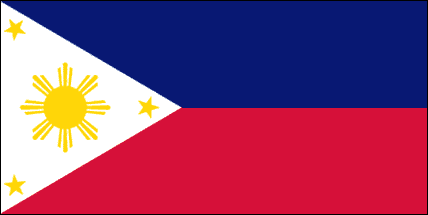
|
Full country name: Philippines Capital city: Manila The flag of the Philippines consists of two horizontal stripes and a white horizontal triangle on the left side of the flag facing the middle. The top stripe is blue and the bottom is red. In each corner of the triangle is a five pointed gold/yellow star. In the center of the triangle there is a large gold/yellow sun.The blue stripe represents patriotism and justice. The red symbolizes valor and the blood spilt for freedom and independence. The white stands for peace and purity. The white triangle symbolic of peace and the Katipunan nationalist organization. The three stars represent the three main geographical divisions of the Philippines - Luzon, Mindanao, and Visayas. The sun represents independence and its eight rays represent the eight provinces that led the Philippine uprising against Spanish rule. The national flag of the Philippines is also the country's war ensign; when the Philippines are at war it is flown upside down, with the red stripe on top of the blue. |
National Flag of Serbia and Montenegro
|
Full country name: Serbia and Montenegro (formerly Yugoslavia) Capital city: Belgrade The flag of Serbia and Montenegro consists of three equal sized horizontal stripes. The top stripe is red, the middle is white, and the bottom stripe is blue.When the flag was originally adopted in 1918 by the Socialist Federal Republic of Yugoslavia, the colors represented the members that made up the former federation. Blue, white, and red are traditional Slavic colors, and together they are referred to as the pan-Slavic colors. The colors stand for Slavic unity and independence. The national flag, arms, and anthem of Serbia and Montenegro are the same as the previous country of Yugoslavia. Serbia and Montenegro is the name of the union of Serbia and Montenegro, two former Yugoslav republics joined together to form a loose federation. The two states agreed only to cooperate in some political fields and they have their own economic policies and currencies. A new national flag for Serbia and Montenegro was proposed by the country's Council of Ministers in 2003 and is awaiting endorsement by Parliament. The proposed flag will have red, blue and white horizontal stripes with the middle blue stripe divided into two shades of blue. One shade will represent Serbia and the other will represent Montenegro. |
National Flag of South Korea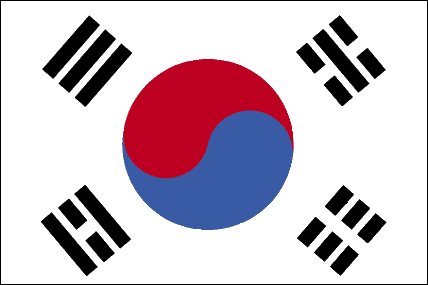
|
Full country name: Republic of Korea (South Korea) Capital city: Seoul The flag of South Korea consists of a white base. In the center of the flag is a blue and red circle, which is surrounded by four black trigrams, one in each corner.White is a traditional color of the Korean people. The emblem in the centre of the South Korean flag represents the dual forces of yin (blue) and yang (red). The yin and yang balance each other and maintain a harmonious existence by being complementary opposites, positive and negative, active and passive, male and female, night and day, good and evil, and so on. Yin is the passive or static mode, and yang the active or dynamic mode. The trigrams represent the elements of fire, water, earth, wood, and metal. In Korean the national flag is called 'Taegukki' ('Great Polarity'), taking its name from the central emblem on the flag, which is called a 'taegeuk circle'. |
National Flag of Virgin Islands
|
Full country name: Virgin Islands (United States) Capital city: Charlotte Amalie The flag of the U.S. Virgin Islands consists of a white base with a yellow bald eagle in the center. The shield of the United States rests on the eagle's chest and the eagle is holding three arrows and an olive branch.The letters V and I, on either side of the eagle stand for the Virgin Islands. The three arrows being held by the eagle symbolize St. Croix, St. Thomas, and St. John; which are the three main islands that make up the U.S. Virgin Islands. The white base of the flag symbolizes purity, and the eagle is displayed with the shield of the United States on its chest. As an unincorporated territory of the United States, the island's flag features parts of the U.S. seal. The US Virgin Islands were formerly called the Danish West Indies, but Denmark sold the islands to the U.S. in 1917 for 25 million dollars. Flags prior to 1917 incorporated the Danish flag in them. |
National Flag of Lithuania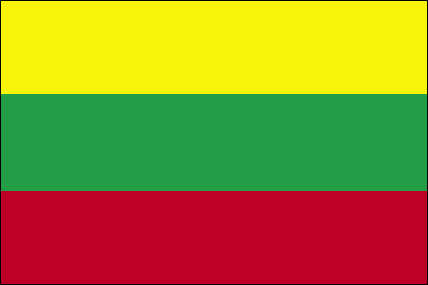
|
Full country name: Republic of Lithuania Capital city: Vilnius The flag of Lithuania consists of three equal sized horizontal stripes - the top stripe is yellow; the middle one is green; and the bottom stripe is red.Lithuanian's flag colors are based on the country's traditional national dress - the yellow stripe represents the sun, Lithuania's fields of wheat, and prosperity; the green symbolizes the country's forests, flora, and hope; and the red stands for the blood spilt for independence, courage, and the people's love for Lithuania. Collectively the colors represent hope for the future, freedom from oppression, and the incredible courage of the Lithuanian people. Homeowners in all three Baltic states of Latvia, Lithuania, and Estonia are obliged to fly their national flags on the Latvian, Lithuanian, and Estonian independence days. Failure to fly the national flag could result in a fine. |
National Flag of Spain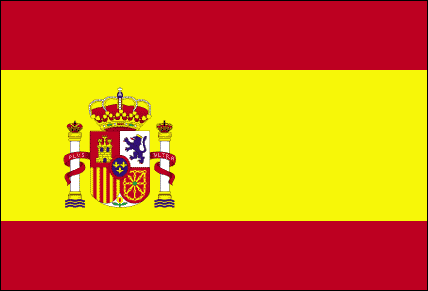
|
Full country name: Kingdom of Spain Capital city: Madrid The flag of Spain consists of three horizontal stripes. The top and bottom stripes are equal-sized and are red; while the middle yellow stripe is double the size of the red stripes. Towards the left side within the yellow stripe is the country's coat of arms. The coat of arms consists of a crowned shield, quartered and guarded on each side by the crowned Pillars of Hercules - representing Gibraltar and Cueta. Each quarter displays badges of the original Spanish kingdoms. In the centre of the shield is the emblem of the reigning Spanish royal Family, House of Bourbon, which is a blue oval with a red-edged border containing three fleur de lies. At the bottom of the shield is a pomegranate representing Grenada. Wrapped around the pillars is a red scroll with the motto 'PLUS ULTRA' written on it which translates to 'there is more beyond'.Red and yellow are traditional Spanish colors and originate from the coat of arms of the original Spanish kingdoms. No other countries used the red and yellow colors at that time. The red and golden-yellow colors of Spain's flag were first used by the King of Spain, as he tried to easily differentiate his ships from those of other countries. A flag oath called the 'jura de bandera' took place every year when Spanish youths ended their military service. Any Spanish citizen could attend the ceremony and take part in the oath. Citizens are not otherwise sworn in to the flag. |
National Flag of Denmark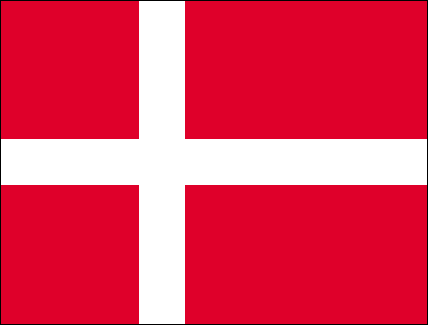
|
Full country name: Denmark Capital city: Copenhagen The Danish flag consists of a red base with an offset white cross. The horizontal stripe of the cross runs across the center of the flag, but the vertical stripe is shifted toward the left side of the flag. The white cross on the Danish flag represents Christianity.Denmark is Europe's oldest kingdom and its flag - the oldest European flag - was officially adopted in 1625 and is generally considered the oldest continuously used national flag in the world. Legend has it that the Danish flag fell from the skies on June 15, 1219, the day in which King Waldemar II defeated the Estonians in battle. Historians, though, think the Danish flag was derived from old crusader banners of that time. The national flag of Denmark is often called the Dannebrog which means 'Danish cloth'. The Danish flag has unusual proportions (ratio) and is almost square in shape. |
National Flag of Brazil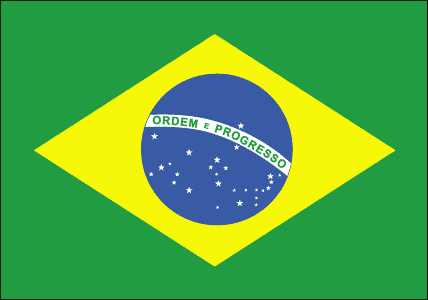
|
Full country name: Federative Republic of Brazil Capital city: Brasilia The flag has a green base; its primary feature is a large yellow rhombus (diamond shape) in the center. Inside the rhombus is a blue celestial globe with white stars of different sizes. A white banner, symbolizing the equator, curves across the circle and on it is the national motto "ORDEM E PROGRESSO" which translates in English to "Order and Progress".The green is symbolic of Brazil's lush fields and forests of the Amazon and the Atlantic Jungle. The yellow rhombus is symbolic of the country's gold reserves, as Brazil was once home to the largest gold mines in world. Between the years 1500 and 1900 more gold was found in Brazil than had previously existed in the entire world. The white five-pointed stars on the blue circle represent the sky over Rio de Janeiro on the night of November 15, 1889, which is the day the Republic of Brazil was declared. Each of the 27 stars represents a different Brazilian state plus the Federal District. The number of stars changes whenever a new state is created. |
National Flag of United States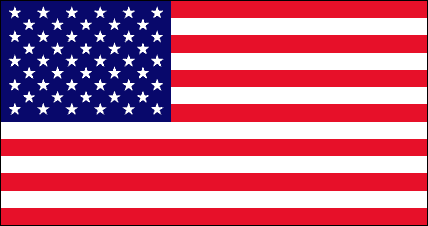
|
Full country name: United States of America Capital city: Washington, DC The National Flag of the United States has thirteen equal horizontal stripes with red (at top and bottom) alternating with white. There is a blue rectangle in the upper hoist-side corner with 50 white five-pointed stars arranged in nine horizontal rows of six stars (at top and bottom) alternating with rows of five stars. The 50 stars represent the 50 states; the 13 stripes represent the 13 original colonies.Known as Old Glory, the design and colors have been the basis for a number of other country flags including Chile, Liberia, Malaysia, and Puerto Rico. |
Click here to download a coloring book of these flags (.PDF file).
Click here to download this web page as a book (.PDF file).